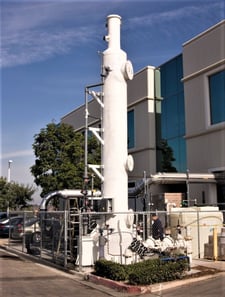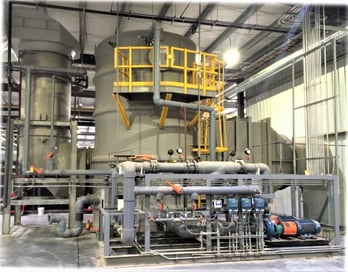 HCl emissions are encountered in a wide range of applications including hazardous waste combustors (HWC), medical waste incinerators, pharmaceutical production, and ceramic tile manufacturing. There is a wide range of performance requirements depending on the application and applicable state or US EPA standard. Below is a summary of performance requirements for some of these applications.
HCl emissions are encountered in a wide range of applications including hazardous waste combustors (HWC), medical waste incinerators, pharmaceutical production, and ceramic tile manufacturing. There is a wide range of performance requirements depending on the application and applicable state or US EPA standard. Below is a summary of performance requirements for some of these applications.
- Hospital, medical, and infectious waste incinerator (HMIWI) MACT standard: 5.1 to 15 ppmv depending on the size of the incinerator and whether it is an existing or new incinerator.
- Hazardous waste combustor (HWC) MACT standard: 32 ppmv for existing incinerators and 21 ppmv for new incinerators; adjusted to 7% O2.
- Ceramic tile kiln scrubber: > 97% removal
- Pharmaceutical manufacturing RTO scrubber: > 99% removal
 It is well known that gaseous HCl readily absorbs into water and can be removed with high efficiency with caustic addition. The challenge however is that a fraction of the inlet HCl condenses into acid aerosol when hot gas from the thermal oxidizer contacts water in the quencher. The aerosol quantity formed and the particle size distribution (PSD) of the acid droplets vary from process to process. Predictive models to accurately estimate these values are limited and imprecise. In some cases as much as 20% of the HCl can form an acid aerosol fog. Aerosol carry-over exhausting from the scrubber will show up in stack tests and contribute to plant emissions.
It is well known that gaseous HCl readily absorbs into water and can be removed with high efficiency with caustic addition. The challenge however is that a fraction of the inlet HCl condenses into acid aerosol when hot gas from the thermal oxidizer contacts water in the quencher. The aerosol quantity formed and the particle size distribution (PSD) of the acid droplets vary from process to process. Predictive models to accurately estimate these values are limited and imprecise. In some cases as much as 20% of the HCl can form an acid aerosol fog. Aerosol carry-over exhausting from the scrubber will show up in stack tests and contribute to plant emissions.
It is common for HCl scrubbers to utilize mesh pads above the packed bed to remove aerosol droplets before exiting the scrubber. As noted above, many applications require 97% to 99% removal efficiency. This arrangement is generally adequate for these removal efficiencies. The proposed NESHAP standards for vinyl chloride facilities, however, requires higher efficiency. This increased efficiency demand requires additional consideration in the scrubber design and mist eliminator to guarantee performance. Facilities should rely on experienced scrubber suppliers that understand HCl aerosol and account for it in the scrubber design to guarantee emission limits.
Click on the link below to download HCl scrubber literature.


